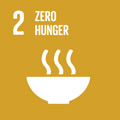- Docente: Assunta Bertaccini
- Credits: 6
- SSD: AGR/12
- Language: Italian
- Moduli: Assunta Bertaccini (Modulo Mod 1) Assunta Bertaccini (Modulo Mod 2)
- Teaching Mode: In-person learning (entirely or partially) (Modulo Mod 1); In-person learning (entirely or partially) (Modulo Mod 2)
- Campus: Bologna
- Corso: Second cycle degree programme (LM) in Agricultural Sciences and Technologies (cod. 9235)
Learning outcomes
The student learns how plants perceive and decode the signals of biotic and abiotic agents of disease, as well as which are the major virulence factors of infectious disease agents. The student will learn critically the current plant protection systems and will be able to design and prepare strategies and innovative methods disease management. Dealing with selected case studies of all kinds of diseases, the student will be enriched in its knowledge about plant diseases and will be stimulated in his creativity and critical thinking about plant pathogens and plant diseases.
Course contents
a) Prerequisites
The student must have good knowledge about fundamentals of biology, botany and plant pathology. He has knowledge of biochemistry and physiology of plants that allow to understand the issues of the course. A basic knowledge of the English language may support the deep understanding of some of the concepts explained.
b) Teaching units
The course consists of two modules divided in 9 teaching units covering:
Module Advanced Plant Pathology 1
1.1) Host-pathogen interactions (4 hours)
a) symbiosis, patosysm, homologous and heterologous systems, compatibility
b) the innate immune system of plants and its activation
2.1) Plant immediate immune response (6 hours)
a) PAMP, MAMP, cell wall receptors, transduction of primary signals
b) activation of signalling networks, oxidative response, ROP
c) immune endocytosis, defensins, transcription factors
d) micro-RNA and RISC complex. Differences between miRNA and siRNA
3.1) Plant mediated immune response (8 hours)
a) activation defence mediated mechanisms by R genes
b) RPL, RLK, TIR-NB-LRR and CC-NB-LRR proteins
c) plant innate immune system and cell apoptosis
d) the role of NB-LRR proteins. Theory of guard protein
4.1) Systemic immune response (8 hours)
a) localized and systemic immune response
b) micro-HR and systemic oxidative response
c) systemic signal molecules
d) octodecanoic pathway
c) plant hormones and the immune response
d) the role of ethylene in the immune response
e) convergences of the signalling network
5.1) Immune response to foreign or aberrant nucleic acids (4 hours)
a) the main immunological mechanisms against foreign nucleic acids
b) AGO and DRB proteins, amplification mechanisms of siRNA
c) gene silencing and its suppression by plant pathogenic virus.
Module Advanced Plant Pathology 2
2.1) Pathogenesis of virus diseases (4 hours)
a) pathogenesis, transmission and mechanical inoculation
b) replication and assembly
c) translation of viral proteins, cycle of a RNA (+) virus
2.2) Spread of the virus in the plant (2 hours)
a) types of infection and virus spread within the plant
b) virulence factors for short and long distance virus spread
c) proteins of movement and capsid proteins
d) repressors of gene silencing in viral diseases
2.3) Transmission of the virus (2 hours)
a) contact, plant parts, vegetative propagation, seed, pollen
b) the types of vectors and of transmission
c) virus classification based on retention period
d) molecular interactions between virus non-persistent and semi-persistent and their vectors
e) nematodes, protozoa and fungi virus vectors
2.4) Study cases (22 hours)
a) virus: sharka of stone fruits, tomato spotted wilt, citrus tristeza virus
b) bacteria: fire blight of pome fruits, brown rot and potato ring; bacterial spot of stone fruits; kiwi canker; grapevine yellows; stone and pome fruit phytoplasmas.
c) oomycetes and fungi: late blight of potato and tomato; root rots; tracheomycosis, root rot
Readings/Bibliography
Teacher's notes available on the web site. Fundamental will be the use of material provided personally by the teacher and lecture notes. For further information the following text is recommended:
G.N. Agrios-Plant Pathology, 2005, fifth edition, Elsevier Academic Press, 922 pages.
Teaching methods
The course consists of lectures and practical exercises divided into two modules: advanced plant pathology 1 and advanced plant pathology 2. As part of the practice, there are guided visits in factories and fields for inspection of plant diseases and laboratory exercises in plant pathology if the condition will allow it.
Assessment methods
The course is part of the Integrated Course "Avversità delle piante" together with the course of "Lotta biologica e integrata agli insetti" therefore, the evaluation of the course takes into account jointly the level of knowledge and skills acquired by the student in relation to both teachings. The two exams could be taken separately only by Erasmus students.
The exam will be conducted by a final oral examination, which ensures the acquisition of knowledge and skills expected. The oral exam consists of questions selected in the 9 teaching units. The duration of the oral examination is estimated to be around 30-40 minutes. The final grade is assigned based on the degree of preparation of the student and especially about its capabilities and critical ability to connect different subjects.
In addition to the fixed exam dates, the teacher is available by e-mail appointment, in agreement with her commitments and institutional research duties.
Teaching tools
Computer and projector. Power point slides. Biology laboratory, optical and binocular microscopes.
Office hours
See the website of Assunta Bertaccini
SDGs




This teaching activity contributes to the achievement of the Sustainable Development Goals of the UN 2030 Agenda.
